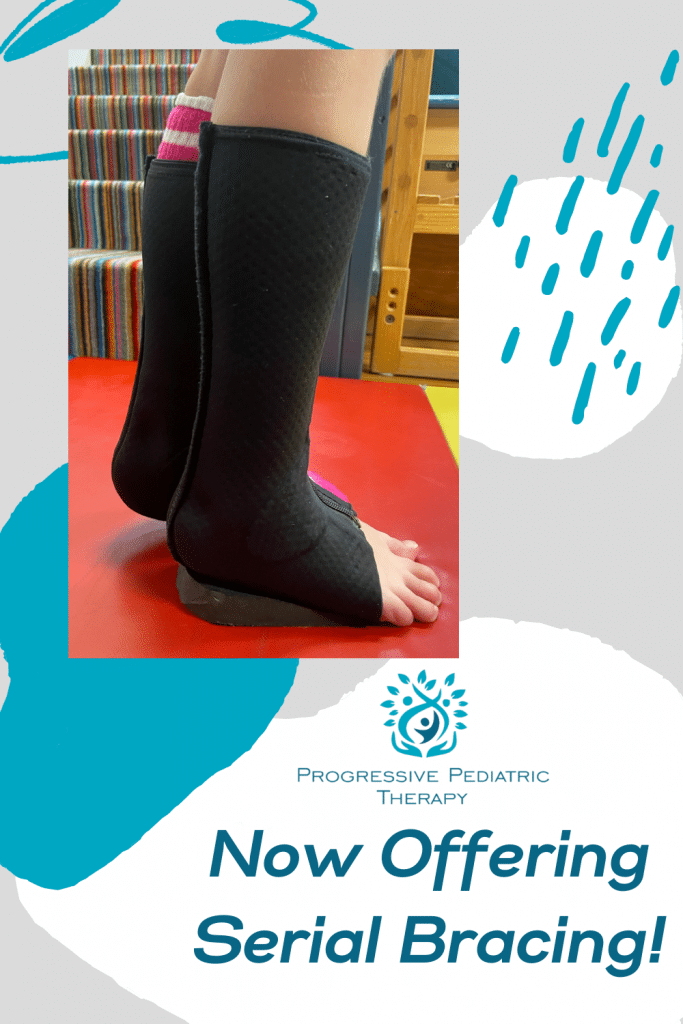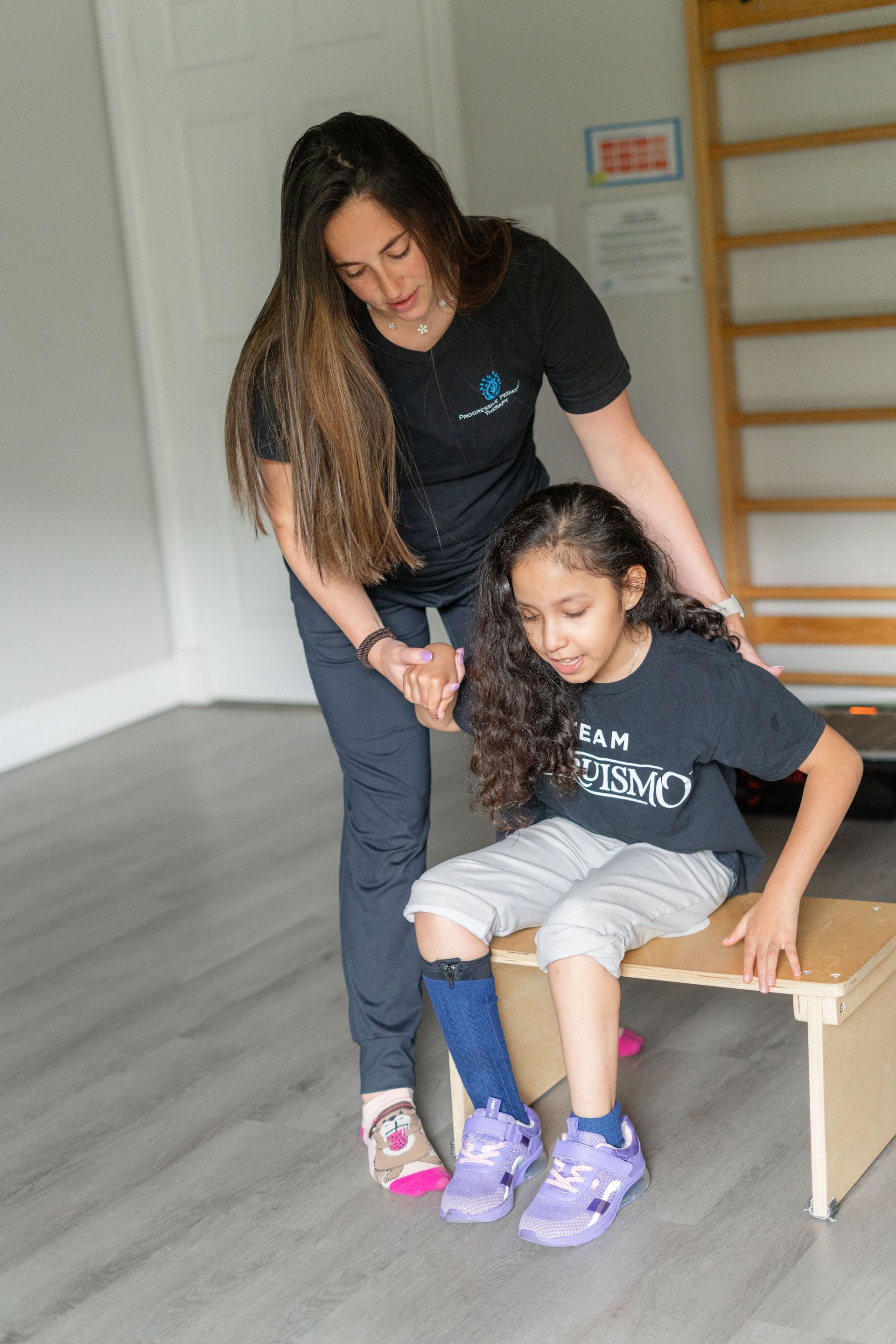Your Clinic
SET A LOCATION
Your Clinic
SET A LOCATION

Serial bracing is a therapeutic intervention used to decrease muscle tightness, change habitual patterns of movement in a single joint, or improve range of motion. It can be used for tight heel-cords (calf muscles), or tightness in the hand, wrist, elbow or knees. Using a re-moldable/removable splint, our therapists will align a joint that is tight in a comfortable but elongated position. The family can remove the brace at any time by simply unzipping it to check the condition of the skin under the brace, do stretching/strengthening exercises, or clean the skin. The brace is typically worn > 16 hours per day/night. After 1-2 weeks of full-time use, the muscles/joints that were tight will begin to relax and the brace can be remolded in better alignment to stretch the muscles/joints a little more.
There are many causes of muscle tightness or contractures, including sensory, muscular, boney or neurological conditions. The therapists at Progressive Pediatric Therapy will help you understand your own child’s unique reason, but usually it is due to a lack of active movement through a joint’s full range of motion.

Your therapist may teach you exercises to improve tolerance to sensory input, stretch the tight muscles, strengthen the opposing muscles, or suggest your child wear special orthotics, splints or braces. The more you are able to do these exercises or wear the splints/braces, the better chance your child has to show improvement in their range of motion.
A common example of this occurs in children who walk on their toes. Despite your best efforts, your child may have a strong urge to remain on their toes. Eventually, that strong habit of toe walking may result in tight heel-cords or muscle contractures in the calf muscles. At that point, your child may not tolerate wearing their braces and it is very difficult for them to stand flat. If your child’s unsupported toe walking and tip-toe position has already resulted in muscle tightness and poor alignment of the foot/ankle bones and muscles, you may be referred to a specialist, such as an orthopedist, neurologist or physiatrist. At that point, interventions such as botox injections, muscle relaxers, serial casting or surgical tendon releases may be discussed.
Every child and family is different. You are encouraged to speak to your child’s doctors about their experiences with children similar to yours. You are also encouraged to research the pros and cons to any intervention to make the best decision for your child. Here is a summary of what you may learn about some common interventions:
| Intervention | Pros | Cons |
| Botox Injections | -Turns off muscle by stopping the neural connection to the muscle at the site of the muscle. -Muscles relax in about 1-2 weeks. -Is a simple injection usually given under light sedation. |
-Wears off usually in 6-10 months. -Often needs to be repeated to maintain effect -May not last as long with repeated injections -Muscle cells eventually change from contractile cells to fibrous tissue. -The brain is constantly having to adapt to the changes in the muscles (from relaxed to tight as it wears off). |
| Medication (Muscle relaxers) | -Relax all muscles in the body. -Can help when tight muscles are causing pain. -May improve the ability to be better positioned or tolerate bracing. |
-Depresses all the nervous system. -May cause sleepiness (initially more than after prolonged use) -May make it harder to activate muscles. -Need to be weaned off slowly. |
| Serial Casting | -Non-invasive. -Typically improves range of motion in 4-6 weeks. -Cannot be removed by child. -Can be repeated at any time as needed. -Less costly than surgery (~$750 per cast limb casted) but may be covered by insurance. |
-Cannot be removed for skin checks, bathing, swimming -May cause pressure injury requiring a period of healing before resuming. -Cannot be removed for stretching and strengthening exercises. -Requires special training, materials and equipment to correctly cast and remove cast. |
| Surgical Tendon Lengthening or Soft Tissue Release | -Immediately improves range of motion. -Often the child can go home that day. -Covered by insurance. |
-Involves Anesthesia, Wound care, Pain. -Usually requires post-op immobilization with a cast splint or boot for 4-6 weeks. -May require time off from school, work, and obtaining special equipment such as a wheelchair or walker. – Costs may be more than $1500 per limb – doctor fee + hospital + anesthesia + equipment -Usually needs new orthotics or splints to maintain alignment afterward. -Muscle tightness may return with growth, progression of condition, or lack of proper post-op positioning and care, requiring repeat surgery. |
The good news is that the answer is yes, and it is a fairly simple answer, using Serial Bracing. Serial bracing is very similar to serial casting however it requires a minimum of time, is relatively inexpensive and can accomplish the same results.

| Intervention | Pros | Cons |
| Serial Bracing | -Non-invasive. -Typically improves range of motion in 4-6 weeks. -Cannot be removed by child. -Can be removed by caregivers for skin check, stretching, strengthening, bathing. -Can easily be remolded in 15-30 minutes per limb at home/clinic without special equipment. -Can be worn for all typical daily/nightly routines, including walking, running, sleeping, swimming or bathing. |
-If removed for sleep or > 6 hours daily will take longer to improve range of motion. -Materials last approximately 4 months of continuous use before worn out. -Requires training to correctly mold. |
Typically, children tolerate the serial bracing well. They may ask for short breaks and you can use that time to do stretching and strengthening exercises. As their range of motion improves, they will develop new motor skills, may be more comfortable, have improved balance and coordination. Often, we see toe walkers become more attentive and slow down their movements since they are not constantly moving to maintain their balance on their toes.
After achieving the desired amount of flexibility (typically 3-4 remolds), your therapist may recommend decreasing the amount of time your child wears the brace during the day or may recommend to just wear it at night. If they are unable to maintain the alignment without the serial brace, your child may need to obtain new orthotics made of more durable plastic such as AFOs or SMOs. If your child does not resume the old position/pattern of movement, then you may just need to continue with exercises prescribed by your therapist to maintain the new alignment.
If your child does tighten up again, you can always reuse the brace to begin the process of serial bracing again at any time, until it is outgrown.
The post Progressive now offers Serial Bracing! appeared first on PPT4Kids.









We empower children, families, and the community to learn, grow, and celebrate every child's unique abilities.
Quick Links
Contact Details
Phone: 561-376-2573 | 561-918-0190
Fax: 561-218-4939
VIP Concierge: 561-717-1764
Clinic Locations
All Rights Reserved | Progressive Pediatric Therapy, Inc. | Privacy Policy | Terms of Service
Site by Spearlance